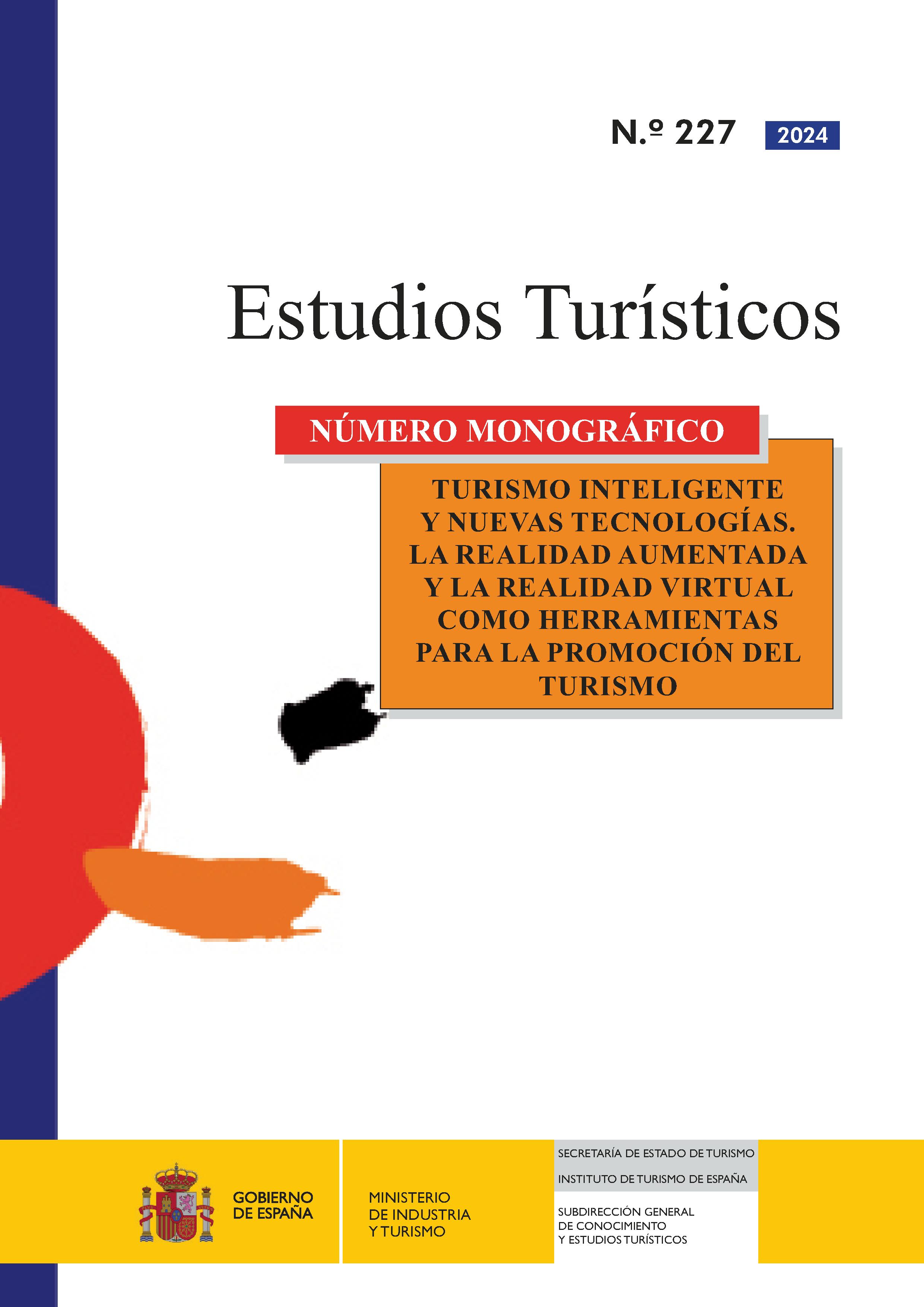Geoescape room A virtual tour of Oviedo
Article Sidebar

This work is licensed under a Creative Commons Attribution-NonCommercial-ShareAlike 4.0 International License.
Main Article Content
Virtual Reality (VR) is a new tourism tool with special application as a first approach to the destination. The evolution of mobile devices has made it possible to increase the capacity of access to this type of resource without the need for other hardware. On the other hand, gamification and especially escape rooms are becoming important tourist resources. Therefore, the proposal of this article is the development of an educational itinerary in gamified format through the city of Oviedo, with the intention of constituting a tourist resource for the younger population.
Article Details
Amalia Jimenez Morales, Departamento de Geografía, Universidad de Oviedo.
Grupo de Investigación Acreditado ARPE-Observatorio del Territorio
Calle Francisco Rodríguez García s/n 33011, Oviedo
Juan López Sánchez, Departamento de Geografía, Universidad de Oviedo
Grupo de Investigación Acreditado ARPE-Observatorio del Territorio
Calle Francisco Rodríguez García s/n 33011, Oviedo
Ícaro Obeso Muñiz, Departamento de Geografía, Universidad de Oviedo
Grupo de Investigación Acreditado ARPE-Observatorio del Territorio
Calle Francisco Rodríguez García s/n 33011, Oviedo.
- Amalia Jimenez Morales, Carmen Rodríguez Pérez, Juan Sevilla Álvarez, Landscape as a resource in tourism and heritage promotion through new technologies , Estudios Turísticos: No. 227 (2024): Turismo inteligente y nuevas tecnologías. La realidad aumentada y la realidad virtual como herramientas para la promocíón del turismo
Adeola, O., & Evans, O. (2019). Digital tourism: mobile phones, internet and tourism in Africa. Tourism Recreation Research, 44(2), 190-202. https://doi.org/10.1080/02508281.2018.1562662
Alonso Almeida, M. del M. (2019). Robots, inteligencia artificial y realidad virtual: una aproximación en el sector del turismo. Cuadernos de turismo, 1(44), 13-26. https://doi.org/10.6018/turismo.44.404711
Amendola, G. (2000). La ciudad postmoderna: magia y miedo de la metrópolis contemporánea. Celeste ediciones
Arbeláez Gómez, M. C. (2014). Las tecnologías de la información y la comunicación (TIC) un instrumento para la investigación. Revista Investigaciones ANDINA, 16(29), 997-1000. https://doi.org/10.33132/01248146.52
Buhalis, D., & Law, R. (2008). Progress in information technology and tourism management: 20 years on and 10 years after the Internet—The state of eTourism research. Tourism management, 29(4), 609-623. https://doi.org/10.1016/j.tourman.2008.01.005
Calle-Lamelas, J. V., García-Hernández, M., & García-Muiña, F. E. (2023). What is a Smart Destination in Practice? The Interpretation of DMO Managers from Spanish World Heritage Cities. Tourism Planning & Development, 1-23. https://doi.org/10.1080/21568316.2023.2214123
Carrillo Rosero, D. A., & Gavilanes González, E. P. (2021). La gamificación como herramienta adicional en la experiencia del viajero. Universidad y Sociedad, 13(S3), 369-373. Recuperado a partir de https://rus.ucf.edu.cu/index.php/rus/article/view/2491
Femenia-Serra, F., Neuhofer, B., & Ivars-Baidal, J. A. (2019). Towards a conceptualisation of smart tourists and their role within the smart destination scenario. The Service Industries Journal, 39(2), 109-133. https://doi.org/10.1080/02642069.2018.1508458
Fernández García, F., & Herrera Arenas, D. (2022). Territorio, paisaje, turismo y tic. La realidad aumentada y la realidad virtual como herramientas para la promoción del turismo (1). Estudios Turísticos, (224), 43-57. https://doi.org/10.61520/et.2242022.13
Gün, E. T., & Atasoy, B. (2017). The effects of augmented reality on elementary school students’ spatial ability and academic achievement. Ted Eğitim ve Bilim, 42(191). http://dx.doi.org/10.15390/EB.2017.7140
Kitchin, R. (2014). The real-time city? Big data and smart urbanism. GeoJournal, 79(1), 1-14. https://doi.org/10.1007/s10708-013-9516-8
Kumar, N., & Kumar, R. R. (2020). Relationship between ICT and international tourism demand: A study of major tourist destinations. Tourism Economics, 26(6), 908-925. https://doi.org/10.1177/1354816619858004
Law, R., Buhalis, D., & Cobanoglu, C. (2014). Progress on information and communication technologies in hospitality and tourism. International journal of contemporary hospitality management, 26(5), 727-750. https://doi.org/10.1108/IJCHM-08-2013-0367
Lee, P., Hunter, W. C., & Chung, N. (2020). Smart tourism city: Developments and transformations. Sustainability, 12(10), 3958. https://doi.org/10.3390/su12103958
Olbrich, J. & Fusté-Forné, F. (2023): Cuando el Turismo se convierte en juego: la gamificación en el turismo cultural en Catalunya. PASOS Revista de Turismo y Patrimonio Cultural 21(1), 9-21. https://doi.org/10.25145/j.pasos.2023.21.001
Olay Varillas, D. & Herrera Arenas, D. (2018). La aplicación de la realidad aumentada al análisis de la dinámica de los paisajes a través de la fotografía. Humanidades Digitales, 147, 87-98
Ozdemir, M., Sahin, C., Arcagok, S., & Demir, M. K. (2018). The effect of augmented reality applications in the learning process: A meta-analysis study. Eurasian Journal of Educational Research, 18(74), 165-186. 10.14689/ejer.2018.74.9
Pencarelli, T. (2020). The digital revolution in the travel and tourism industry. Information Technology & Tourism, 22(3), 455-476. https://doi.org/10.1007/s40558-019-00160-3
Racherla, P., Hu, C., & Hyun, M. Y. (2008). Exploring the role of innovative technologies in building a knowledge-based destination. Current issues in tourism, 11(5), 407-428. https://doi.org/10.1080/13683500802316022
Ráthonyi, G. (2011). Information and Communication Technologies in tourism. Acta Agraria Debreceniensis, (44), 49-53. https://doi.org/10.34101/actaagrar/44/2605
Sánchez Jiménez, M. A., Fernández Allés, M.T. & Mier-Terán Franco, J. J. (2018): Revisión teórica de la relevancia de las nuevas tecnologías de la comunicación (TOC) en el sector turístico. TURYDES Revista sobre Turismo y Desarrollo local, 11(24),
Villar Lama, A. (2018): Ocio y turismo millennial: el fenómeno de las salas de escape. Cuadernos de turismo, (41), 615-636. https://doi.org/10.6018/turismo.41.327181
Wang, Y., de Almeida Correia, G. H., Van Arem, B., y Timmermans, H. H. (2018). Understanding travellers’ preferences for different types of trip destination based on mobile internet usage data. Transportation Research Part C: Emerging Technologies, 90, 247-259. https://doi.org/10.1016/j.trc.2018.03.009
Xiang, Z., Du, Q., Ma, Y., & Fan, W. (2017). A comparative analysis of major online review platforms: Implications for social media analytics in hospitality and tourism. Tourism Management, 58, 51-65. https://doi.org/10.1016/j.tourman.2016.10.001
Yavuz, M., Cavusoglu, M., & Corbaci, A. (2018). Reinventing tourism cities: Examining technologies, applications, and city branding in leading smart cities. Journal of Global Business Insights, 3(1), 57-70. https://doi.org/10.5038/2640-6489.3.1.1029
Yuen, S. C. Y., Yaoyuneyong, G., & Johnson, E. (2011). Augmented reality: An overview and five directions for AR in education. Journal of Educational Technology Development and Exchange (JETDE), 4(1). https://doi.org/10.18785/jetde.0401.10

